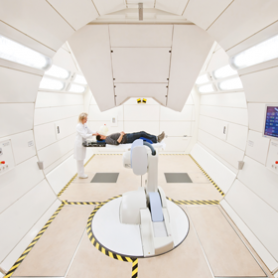Oncology on another level

Ion beam therapy is a unique form of cancer therapy as it avoids side-effects through targeted radiation. Proton or carbon ions are accelerated up to 75% of light speed and directed very precisely into the tumor, irreversibly damaging the tumor while the surrounding tissues remain unharmed and fewer side effects occur. Since 2009, the Heidelberg Ion Beam Therapy Centre (HIT) has been providing this therapeutic option for tumors located deep in the body or in very critical tissue environments; making it possible to provide a treatment that is both gentle and effective, so that tumors that were once especially difficult to treat can now be successfully treated. HIT is the first centre in Europe to provide a gantry for the combined treatment with proton and carbon ions.
HIT at a glance
- Targeted and gentle treatment against certain cancer types
- 700 patients per year
- Extensive experience in treating children and adolescents
- Treatment duration per session: several minutes up to maximum 60 minutes
- Over 95% of patients are treated as outpatients
- HIT facility is located 45 minutes from Frankfurt airport
- HIT is one of a few centres worldwide offering carbon ion (also called heavy ion) therapy
Specialists at HIT are internationally recognised cancer experts and have extensive experience in the treatment of cancer. Thanks to the state-of-the-art equipment at HIT, protons and carbon ions can be directed at the tumor with the highest precision. The world’s first carbon ion gantry – a 600 tonne steel a construction – makes it possible to direct rays at the body from different angles, therefore sparing surrounding tissue to the maximum. An intensity-modulated raster scan procedure, developed by Heidelberg experts, ensures the high-precision dose distribution.
HIT is closely connected to the National Center for Tumor Diseases (NCT) at Heidelberg University Hospital, Germany’s first comprehensive cancer centre and a leading European oncological centre. For all cancers, almost all advanced treatments are available. For complex situations, an interdisciplinary team of experts decide the appropriate treatment for each patient. If needed, combined chemotherapy can be offered in the adjacent buildings of the Children’s Hospital or the National Center for Tumor Diseases (NCT). For further treatment, experts at more than 40 medical departments at Heidelberg University Hospital are available.
Further information
www.heidelberg-university-hospital.com


